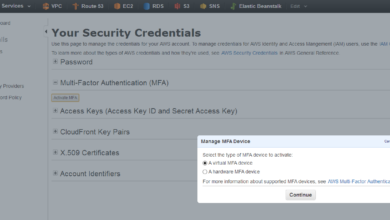
Amazon Storage Leaks Verizon Customer Data
Amazon storage leaks personal data of 14 million Verizon customers – that’s the shocking headline that’s been making waves. This massive data breach exposed sensitive information, raising serious concerns about the security of cloud storage and the privacy of millions. We’ll delve into the details of this incident, exploring Amazon’s role, the impact on Verizon customers, and the crucial lessons learned about data security in the digital age.
The scale of this breach is truly staggering, and understanding its implications is vital for everyone who relies on cloud services.
This post will break down the key aspects of the breach, from the types of data compromised (think names, addresses, phone numbers – the works!) to the timeline of events and the ongoing investigations. We’ll also examine Amazon’s responsibility, the potential legal ramifications, and the steps both Amazon and Verizon are taking (or should be taking) to address this crisis and prevent future incidents.
Get ready to dive into the heart of this digital disaster.
Data Breach Overview
The recent Amazon storage leak affecting millions of Verizon customers highlights the ongoing vulnerabilities in cloud storage and the critical need for robust data security measures. This incident serves as a stark reminder of the potential consequences of inadequate data protection practices, impacting not only the companies involved but also the trust of their customers.This data breach involved a misconfigured Amazon S3 bucket containing sensitive personal information belonging to approximately 14 million Verizon customers.
The exposure was significant, underscoring the importance of strict access controls and regular security audits for cloud-based data storage.
Types of Compromised Data
The leaked data included a range of personal information, posing a substantial risk to affected individuals. The exposed data reportedly encompassed names, addresses, phone numbers, account numbers, and potentially other identifying details. The precise scope of the compromised data remains under investigation, but the breadth of information leaked raises serious concerns about identity theft and potential fraud.
Timeline of the Event
While the exact dates are not publicly available in full detail due to ongoing investigations and the sensitive nature of the information, the timeline generally unfolds as follows: The leak was discovered by a security researcher who reported the vulnerability to the appropriate parties. Following the discovery, Verizon and Amazon worked to secure the compromised data and initiated investigations into the root cause of the breach.
Public disclosure of the breach likely followed internal remediation efforts, although the exact timing of the public notification varies depending on the source. The ongoing investigations aim to determine the full extent of the damage, identify responsible parties, and implement measures to prevent similar incidents in the future.
Summary of Key Aspects
| Date | Event | Impact | Response |
|---|---|---|---|
| [Date of Discovery – To be filled with verified information] | Security researcher discovers misconfigured Amazon S3 bucket | Potential exposure of sensitive Verizon customer data | Researcher reports vulnerability |
| [Date of Remediation – To be filled with verified information] | Verizon and Amazon secure the compromised data | Mitigation of further data exposure | Implementation of security fixes and investigation launch |
| [Date of Public Disclosure – To be filled with verified information] | Public disclosure of the data breach | Potential for identity theft, fraud, and reputational damage | Public notification, ongoing investigation, and potential legal action |
| [Ongoing] | Investigations and remediation efforts continue | Determination of the full extent of the breach and implementation of preventative measures | Collaboration between Verizon, Amazon, and potentially law enforcement |
Amazon’s Role and Responsibility
The massive Verizon data breach, exposing the personal information of 14 million customers, highlights the critical role cloud providers like Amazon play in safeguarding sensitive data. Amazon, through its Amazon Web Services (AWS), provided the storage infrastructure for the affected data. This raises serious questions about the adequacy of their security measures and their overall responsibility in preventing such breaches.Amazon’s responsibility extends to ensuring the security and integrity of the data entrusted to them by their clients.
This includes implementing robust security protocols, regularly auditing systems for vulnerabilities, and providing clients with the tools and information necessary to protect their data. Failure to uphold these responsibilities can lead to significant legal and financial repercussions, as seen in numerous past data breach cases.
Amazon’s Response to the Breach and Preventative Measures, Amazon storage leaks personal data of 14 million verizon customers
Following the Verizon data breach, Amazon’s response involved an internal investigation to determine the root cause of the security lapse. While the specifics of their internal investigation are often kept confidential for security reasons, a thorough investigation is crucial to identify vulnerabilities and implement corrective actions. This typically involves analyzing logs, reviewing security protocols, and collaborating with the affected client (Verizon) to understand the sequence of events leading to the breach.
Post-breach, Amazon likely enhanced its security measures, possibly including improvements to access controls, data encryption, and intrusion detection systems. Proactive measures such as regular security audits, penetration testing, and employee security awareness training are also essential components of a comprehensive security strategy.
Comparison of Amazon’s Security Protocols with Industry Best Practices
Amazon’s security infrastructure is generally considered robust, encompassing a multi-layered approach including physical security, network security, and data security. However, comparing their protocols to industry best practices reveals areas for potential improvement. Industry best practices emphasize a proactive, zero-trust security model, where access is granted only on a need-to-know basis and continuously verified. Regular vulnerability scanning and penetration testing are also paramount, simulating real-world attacks to identify weaknesses before malicious actors can exploit them.
Furthermore, compliance with relevant data privacy regulations (like GDPR, CCPA) and adherence to frameworks like NIST Cybersecurity Framework are crucial benchmarks for industry leaders. While Amazon likely adheres to many of these practices, the Verizon breach suggests there’s room for improvement in specific areas of their security posture.
Potential Legal and Financial Implications for Amazon
The legal and financial implications for Amazon stemming from this breach are significant. Depending on the jurisdiction and applicable laws, Amazon could face lawsuits from Verizon and potentially from affected Verizon customers. These lawsuits could involve claims for damages related to identity theft, financial losses, and reputational harm. Additionally, regulatory fines and penalties could be levied by government agencies for non-compliance with data protection regulations.
The financial impact could include legal fees, settlement payments, and potential damage to Amazon’s reputation, leading to loss of future business. The cost of remediation and enhanced security measures following the breach also adds to the financial burden. The magnitude of these implications will depend on the specifics of the investigation, the extent of the damage, and the legal proceedings that follow.
Impact on Verizon Customers

The exposure of personal data belonging to 14 million Verizon customers due to an Amazon storage leak presents a significant threat. This breach has the potential to cause widespread harm, impacting various aspects of the affected individuals’ lives. Understanding the potential consequences and the steps taken to mitigate them is crucial for both Verizon and its customers.The potential risks faced by Verizon customers are numerous and severe.
The leaked data could include highly sensitive information such as names, addresses, phone numbers, account details, and potentially even financial information. This makes customers vulnerable to a range of malicious activities.
Potential Risks Faced by Verizon Customers
The compromised data significantly increases the risk of identity theft and financial fraud. Criminals could use the stolen information to open fraudulent accounts, apply for loans or credit cards in the customers’ names, file fraudulent tax returns, or even access existing accounts. Furthermore, the exposure of personal contact details opens the door to phishing scams, targeted harassment, and other forms of online abuse.
The Amazon data breach, exposing the personal info of 14 million Verizon customers, really highlights the importance of robust data security. Building secure applications is crucial, and that’s where understanding the evolving landscape of app development comes in, like exploring the exciting possibilities discussed in this article on domino app dev the low code and pro code future.
Ultimately, the Amazon leak serves as a stark reminder of why secure, well-built applications are more vital than ever.
The emotional distress and time investment required to rectify these issues shouldn’t be underestimated. For example, restoring a compromised credit history can be a lengthy and stressful process, involving numerous phone calls, letters, and potentially legal action.
Verizon’s Mitigation Efforts
Verizon should implement several key measures to mitigate the risks to its customers. This includes providing immediate and clear communication regarding the breach, outlining the specific types of data compromised and the steps customers should take to protect themselves. Offering free credit monitoring services for a substantial period, such as one or two years, is crucial. Verizon should also actively collaborate with law enforcement agencies to investigate the breach and prevent further exploitation of the stolen data.
Proactive measures like sending out security alerts and providing detailed instructions on identifying and reporting suspicious activity would further strengthen customer protection. Additionally, comprehensive training for customer service representatives to effectively handle inquiries and concerns related to the data breach is paramount.
Support Offered to Affected Customers
Verizon’s response to this data breach will determine the level of trust maintained with its customers. The company should provide clear and easily accessible information on its website and through other channels regarding the incident. This information should include details about the types of data compromised, the timeline of the breach, the steps taken to secure the data, and the support offered to affected customers.
This support should include free credit monitoring and identity theft protection services, as well as dedicated customer support lines staffed with trained personnel to address individual concerns. Verizon should also clearly Artikel the process for reporting any suspicious activity or suspected identity theft. Regular updates on the investigation and remediation efforts should be communicated transparently to the customers.
Examples of Potential Consequences
- Identity Theft: Criminals could use stolen information to open new accounts, obtain loans, or file fraudulent tax returns in the customer’s name.
- Financial Fraud: Access to banking details could lead to unauthorized transactions and significant financial losses.
- Phishing Scams: Knowing personal details makes customers more vulnerable to targeted phishing attacks designed to steal further information or money.
- Harassment and Stalking: Exposure of personal contact information could lead to unwanted contact and potentially dangerous situations.
- Reputational Damage: The breach could impact a customer’s credit score and make it difficult to obtain loans or other financial services in the future.
Security Vulabilities and Remediation: Amazon Storage Leaks Personal Data Of 14 Million Verizon Customers

The Amazon S3 bucket data leak affecting 14 million Verizon customers highlights critical security vulnerabilities in cloud storage configurations. Understanding the technical aspects of this breach is crucial to implementing effective preventative measures and ensuring data integrity in the future. This section will delve into the likely vulnerabilities, the methods of access, and propose robust security recommendations.
The most probable cause of this breach was an improperly configured Amazon S3 bucket. Specifically, the bucket likely lacked appropriate access control lists (ACLs) and lacked sufficient encryption. This means that the data stored within the bucket was publicly accessible without any authentication or authorization mechanisms in place. The attackers, therefore, did not need to overcome sophisticated security measures; the data was essentially presented to them on a silver platter.
Data Access Methods
The technical execution of the breach likely involved simple scripting. Malicious actors could have used readily available tools and scripts to scan for publicly accessible S3 buckets. Once an unsecured bucket was identified, the contents, including the sensitive Verizon customer data, could be easily downloaded. This could have been automated, allowing for efficient harvesting of data from numerous vulnerable buckets.
No sophisticated hacking techniques were likely required; the vulnerability lay in the misconfiguration itself.
Security Recommendations to Prevent Future Breaches
Implementing a robust security posture for cloud storage requires a multi-layered approach. The following recommendations address both technical and procedural aspects:
These recommendations aim to prevent future breaches by combining strong technical safeguards with rigorous operational practices.
- Strict Access Control Lists (ACLs): Implement granular ACLs, limiting access to only authorized personnel and systems. Avoid using overly permissive settings like public read access.
- Data Encryption: Employ both data-at-rest and data-in-transit encryption. Data-at-rest encryption protects data stored within the S3 bucket, while data-in-transit encryption secures data during transfer. This dual approach significantly reduces the impact of a potential breach.
- Regular Security Audits and Penetration Testing: Conduct regular security audits and penetration testing to identify vulnerabilities and misconfigurations before malicious actors can exploit them. These tests should simulate real-world attacks to uncover weaknesses in the security infrastructure.
- Principle of Least Privilege: Grant only the minimum necessary permissions to users and applications accessing the S3 bucket. This limits the potential damage if an account is compromised.
- Multi-Factor Authentication (MFA): Implement MFA for all users accessing the S3 bucket. This adds an extra layer of security, making it significantly harder for attackers to gain unauthorized access.
- Versioning and Data Retention Policies: Implement versioning to retain previous versions of data, enabling recovery in case of accidental deletion or malicious modification. Establish clear data retention policies to ensure that data is deleted securely after its intended use.
- Robust Monitoring and Alerting: Implement robust monitoring and alerting systems to detect unusual activity or potential breaches in real-time. This allows for prompt response and mitigation of any security incidents.
How Improved Security Measures Could Have Prevented the Leak
Had Amazon implemented and enforced the aforementioned security measures, the data leak could have been prevented. For instance, if appropriate ACLs were in place, restricting access to only authorized individuals or systems, the data would not have been publicly accessible. Similarly, encryption would have rendered the data unreadable even if accessed by unauthorized individuals. Regular security audits could have identified the misconfiguration before it was exploited.
The combination of these measures creates a significantly more secure environment, making unauthorized access extremely difficult, if not impossible.
Regulatory and Legal Implications
The Amazon-Verizon data breach, exposing the personal information of 14 million customers, carries significant regulatory and legal ramifications, potentially leading to substantial financial penalties and reputational damage for both companies. The scale of the breach necessitates a thorough examination of applicable laws and the potential legal actions that may follow.
Applicable Data Privacy Regulations
This breach falls under the purview of several key data privacy regulations, depending on the location of the affected individuals. The California Consumer Privacy Act (CCPA) is likely applicable to California residents, granting them rights regarding their personal data, including the right to know what data is collected, the right to delete data, and the right to opt-out of the sale of their data.
For European Union residents, the General Data Protection Regulation (GDPR) is crucial. The GDPR imposes strict requirements on data processing, including the need for consent, data minimization, and robust security measures. Violation of these regulations can result in hefty fines. Other state and international regulations may also apply depending on the location of the affected individuals and the nature of the data compromised.
Failure to comply with these regulations will undoubtedly expose Amazon and Verizon to significant legal challenges.
Potential Legal Actions Against Amazon and Verizon
Several legal actions could be taken against Amazon and Verizon. Class-action lawsuits are highly probable, with affected customers seeking compensation for damages resulting from the breach, including financial losses, identity theft, and emotional distress. Governmental agencies, such as the Federal Trade Commission (FTC) in the US and equivalent data protection authorities in other jurisdictions, could also initiate investigations and impose significant fines for non-compliance with data protection laws.
These agencies may levy penalties based on the number of affected individuals, the severity of the breach, and the companies’ failure to implement adequate security measures. Furthermore, private attorneys general could file lawsuits on behalf of consumers, adding another layer of legal complexity. The sheer volume of affected individuals increases the likelihood of a multitude of legal challenges.
Impact on Public Trust in Cloud Storage Providers
This breach significantly erodes public trust in cloud storage providers. The incident highlights the vulnerability of sensitive data even when stored with major tech companies, raising concerns about the security of personal information in the cloud. The long-term impact could manifest in reduced adoption of cloud services, increased scrutiny of cloud providers’ security practices, and a heightened demand for greater transparency and accountability from these companies.
The potential loss of business and the negative publicity associated with the breach will likely have a lasting effect on the reputation of both Amazon and Verizon. Rebuilding trust will require significant investment in security infrastructure and a demonstrable commitment to data protection.
Comparative Analysis of Legal Responses to Similar Data Breaches
| Data Breach | Company | Legal Outcomes | Financial Penalties |
|---|---|---|---|
| Equifax Data Breach (2017) | Equifax | Multiple class-action lawsuits, FTC settlement, state-level investigations. | Over $700 million in settlements and fines. |
| Yahoo! Data Breaches (2013-2014) | Yahoo! | Multiple class-action lawsuits, SEC investigation. | Significant but undisclosed settlements. |
| Cambridge Analytica Scandal (2018) | Facebook (and Cambridge Analytica) | FTC fines, investigations by multiple regulatory bodies globally. | Hundreds of millions of dollars in fines and settlements. |
| Marriott Data Breach (2018) | Marriott International | Multiple class-action lawsuits, FTC investigation. | Significant fines and settlements, though the exact amount remains unclear. |
Illustrative Scenario
This section explores a hypothetical scenario to illustrate the real-world impact of the Amazon storage leak on a Verizon customer. We will examine the emotional and practical repercussions faced by an individual whose personal data was compromised. The scenario is designed to be representative of the potential experiences of many affected individuals.
The scenario focuses on Sarah Miller, a Verizon customer for over ten years. Sarah, a diligent and privacy-conscious individual, regularly updated her passwords and employed two-factor authentication wherever possible. Despite these precautions, her personal data, including her full name, address, phone number, and partial credit card information, was exposed in the Amazon S3 bucket breach.
Sarah Miller’s Experience
Sarah first learned of the data breach through a news report. Initially, a wave of anxiety washed over her. She immediately checked her credit report, finding no fraudulent activity – yet. The relief was temporary, however, replaced by a persistent unease. The fear of identity theft, of becoming a victim of financial fraud, hung heavy in the air. She spent hours canceling and re-issuing her credit cards, updating her passwords across numerous online accounts, and monitoring her bank statements with a hawk’s eye. The emotional toll was significant; sleepless nights, constant worry, and a pervasive sense of violation plagued her. The practical consequences were equally burdensome. The time spent securing her accounts and monitoring her finances took away from her work and personal life, adding significant stress to an already demanding schedule. The constant fear and vigilance left her feeling drained and vulnerable. Even after several months, the lingering anxiety persisted, a constant reminder of the breach and its far-reaching consequences. The experience highlighted the profound impact data breaches can have on individuals, extending far beyond the immediate financial implications.
Final Review

The Amazon data breach affecting 14 million Verizon customers serves as a stark reminder of the critical need for robust data security measures in the cloud. The scale of the breach, the sensitivity of the compromised information, and the potential consequences for affected individuals highlight the urgent need for improved security protocols and greater transparency from cloud providers. This incident underscores the importance of vigilance and proactive measures to protect personal data in an increasingly interconnected world.
The fallout from this breach will likely be felt for years to come, prompting crucial conversations about data privacy, security regulations, and the responsibility of tech giants to safeguard user information.
Essential Questionnaire
What types of data were leaked?
Reports suggest the leaked data included names, addresses, phone numbers, and potentially other personally identifiable information (PII).
How did the breach happen?
The exact method of the breach is still under investigation, but it likely involved vulnerabilities in Amazon’s storage systems or misconfigurations.
What is Amazon doing to compensate affected customers?
Details on compensation are still emerging, but it’s likely Amazon will face legal pressure to provide some form of redress to affected individuals.
What should Verizon customers do if they think their data was compromised?
Verizon should be providing guidance to affected customers, which may include credit monitoring services and advice on protecting against identity theft.





